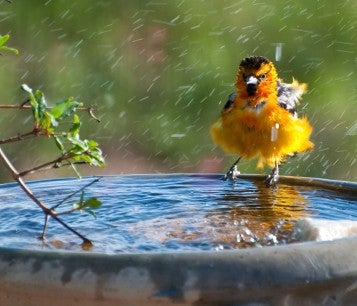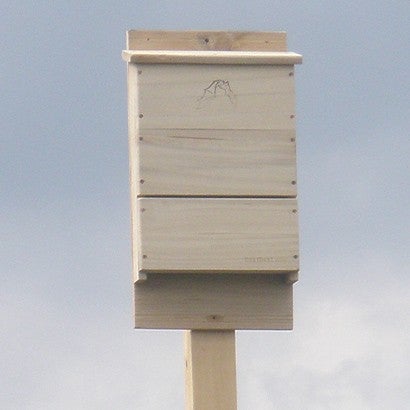Bats are fascinating animals; they are the world’s only flying mammal and can fly at speeds over 100 miles an hour. They also play a vital role in their ecosystems by pollinating fruits, dispersing seeds and keeping insect populations balanced.
There are more than 40 bat species in the U.S. and Canada, but only a few kinds of bats ever cause problems for people. No, bats won't suck your blood or get tangled in your hair—but they may take up residence in your attic to raise their young.
Contents
No matter how big or small your outdoor space, you can create a haven for local wildlife. By providing basic needs like water, food and shelter, you can make a difference in your own backyard.

Are bats harmful?
Bats, like any other mammal, can carry rabies, but the incidence of rabies in bat populations is extremely low. Bats who do contract rabies die quickly, so they don’t cause an ongoing threat. Follow normal safety practices: Do not handle bats with bare hands, warn children not to handle bats, and vaccinate dogs and cats for rabies.
The National Centers for Disease Control and Prevention (CDC) recommends capturing and testing any bat found in a room with a sleeping or incapacitated person or unsupervised small child. This means the bat will be killed to perform the test. This recommendation is made as a precaution, because people, children and the elderly especially, may be unaware of a bite from tiny bat teeth. In any situation of potential rabies exposure, immediately consult your physician and local health authorities.
If you find a bat on the ground outside, it doesn’t mean the bat is rabid. They may be ill, temporarily stunned from flying into a window, or—if the weather is colder—too chilled to fly. Call your local animal control agency or a wildlife rehabilitator for assistance.
What should I do about a bat in the living space of my house?
Sometimes a bat may go off course and accidentally find their way into the living space of a home. This is no cause for alarm. Stay calm, keep pets and children away and follow these steps to remove them safely and humanely. Close interior doors and give the bat a way to get outside. The bat will tend to fly in a U-shaped path, flying higher near the walls and lower in the center of the room, so keep near a wall. If the bat doesn't exit on their own, it is best to wait until they land to try to catch them.
Important: Never try to handle a bat with your bare hands.
Wear thick work gloves—but not cotton, as most bats can easily bite through cotton. If gloves are not available, you can capture a bat in a rolled-up T-shirt or something of similar material. Make sure there is enough thickness to the material used so you will not be bitten. (Don't use a towel, as the bat’s claws might get snagged in its loops.)
Bats will most likely land somewhere they can hang—behind curtains or upholstered furniture, on hanging clothes or in house plants. Carefully place a plastic tub or similar container over them. Gently work a piece of cardboard or stiff paper under the container, trapping the bat inside. Now you are ready to release the bat outdoors.
Because most bats cannot take flight from the ground, tilt the container or allow the bat to climb a tree trunk or other vertical surface.
Important: If there is a possibility that a bat has bitten someone, the Centers For Disease Control (CDC) recommends the bat be tested for rabies. Contact your local animal control agency and physician about this.
Next, find how they got in. The bat may have been roosting somewhere in the house and mistakenly found their way to the living space. Common entry points include gaps and openings that lead to attics or cellars—places that may harbor more bats. Inspect thoroughly and seal potential interior entrances.
How do I remove bats from my attic or inside my walls?
Successfully evicting bats from attics and inside walls can be challenging. A knowledgeable professional who understands bat behavior and laws protecting bats may be your best option.
Bat Conservation International has information about and criteria for selecting a professional wildlife company that is experienced in humane bat eviction and exclusion. Your state wildlife agency may also be a resource to find help.
Do not evict bats from your home when dependent young are present (May through August). Many states specifically prohibit excluding bats when they are raising young. Early autumn is the best time to evict bats. If you find hibernating bats during the winter, wait until spring when the bats will be able to fend for themselves.
After bats have been successfully evicted from your home, be sure to properly seal up any entry points. Many homeowners who recognize the value of having bats at work for insect control will opt to put up a bat house at the time of eviction, hoping the bats will find and use it or occupy it on return the next spring.
How can I prevent bats from getting in my home?
Bats don't make holes to get into buildings; they use entry points we leave open. Small openings or narrow gaps high on houses allow bats to enter. Bats may also enter under loose-fitting doors, around windows, unscreened chimneys, and through gaps around conduits and utility vents; they only need a gap of 3/4" to 1" to enter. Plug any gaps with door draft guards, hardware cloth, steel wool or caulking. If you need to evict bats from your home, do so in early spring or in fall, when flightless young will not be present.
Mylar or flash tape may repel bats from carports and gazebos, and plastic sheets attached with staples so that the bat cannot grasp onto the favored part of the structure will work as well. Make sure to put staples no more than an inch apart, so that the bat cannot crawl under the sheeting and get stuck.


